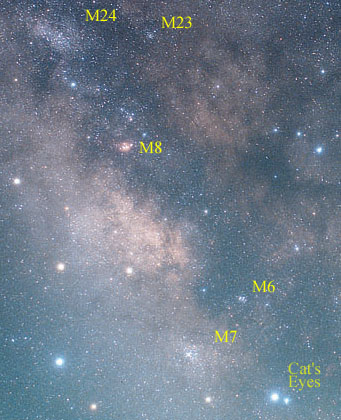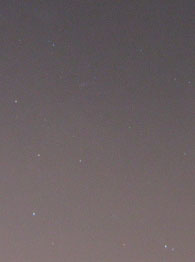Last night was the first of this lunation to have decent transparency and no Moon in the evening sky. It's not unusual to get just once such night per month here in the eastern U.S., so I couldn't waste the opportunity.
Ideally, I would drive far away to a semi-dark site on every moonless night, but there's a limit to how long I can stay awake after a hard day's work. And I had little desire to waste an hour or two of that precious evening sitting behind the wheel of a car.
This is exactly the kind of situation where it's really handy to have a suburban stargazing project in my pocket. I can with a clean conscience "waste" the moonless night in the suburbs because I have to complete my project. (Actually, my observing career is littered with projects that never got completed, but I can overlook that fact when it's convenient.)
So off I drove to Arlington, MA, the next town out from Cambridge, where I'm viewing as many Messier objects as possible through my 70-mm refractor. I've done that already near my home in Cambridge, but I think that Arlington is more representative of typical stargazer habitat. Most people in Arlington live in detached single-family homes, though the houses are packed together quite tightly. It has about 8,000 people per square mile -- roughly the same as Los Angeles, though just half the density of Cambridge or San Francisco. The skies in Arlington average about ½ mag darker than near my home. That's enough to make 7 stars visible in the Little Dipper with considerable effort, and to show just a hint of the Cygnus Starcloud when it's directly overhead.

Under a dark sky, all the labeled objects are readily visible to the unaided eye, as are the star clouds and the dark lanes that crisscross them. But you'd need small binoculars to resolve this many individual stars.
Akira Fujii
I ended up viewing just 5 Messier objects in 1{1/2} hours: M4, M80, M7, M6, and M23. Under dark skies, the last three of these are readily visible naked-eye. Many people can also see M4 without optical aid, though I can't due to the glare of nearby Antares. But my 10x30 binoculars show all five of these star clusters with ease. And when I push the binoculars' image-stabilization (IS) button, I can resolve many stars in M7 and M6, and a few in M23.
In Arlington, I was doubly handicapped, both by the light pollution and by the fact that these objects are always very low in the sky when seen from latitude 42° N. According to my measurements, the sky 3 is times brighter 20° above the southern horizon than at the zenith at this site, and 6 times brighter 10° above the horizon.

This shows the same section of sky as the photo above, but taken from Arlington, MA. Note that both M7 and M8 show up faintly despite the massive light pollution.
Tony Flanders
I scanned and star-hopped for a long time with my 10x30 binoculars, but the only one of the five clusters that I could see was M7. It did show pretty well, though, resolving about 10 individual stars when I pressed the IS button.
Through a telescope, M4 was soberingly difficult to see. I've had this experience before, in Cambridge, but hoped things would be easier in Arlington. All I could make out was an extremely vague, though large, blob, and it only appeared with averted vision when I was consciously moving my eye. If it hadn't been in exactly the right spot, I wouldn't have been 100% sure I'd seen. No wonder this globular cluster causes trouble for neophyte backyard astronomers. It's all light pollution's fault!
M80 is much tougher than M4 at a dark site, but vastly easier in city or suburbs. That's because it's a concentrated cluster with lots of stars packed into a tiny chunk of sky. That makes it stand out much better against the skyglow, as long as you use enough magnification to see that it's not just a single star.
The most interesting case was M23. At low magnification, I couldn't see a thing; the diffuse glow of unresolved stars was swamped by the background skyglow. But when I boosted the magnification to 60X, 20 individual stars suddenly appeared out of nowhere. They'd been just below the threshold of visibility at low power.
A passing bank of clouds gave me an excuse to go home. I was still having fun, but I didn't want to loose too much sleep in advance of the big new-Moon/Perseid/Stellafane weekend. I felt a little rueful thinking how much more beautiful all the things I'd been viewing would have been under a dark sky — to say nothing of being easier to locate! But better to see them in adverse conditions than not at all.
 2
2









Comments
Paul Vondra
August 10, 2007 at 11:20 pm
Interesting article. I have observed for a number of yesars from my home in Bellevue PA just six miles from downtown Pittsburgh with my 4 1/2" Orion StarQuest reflector, battling both immediate glare from porch;lights, streetlights, etc., as weel as ambient light pollution, to say nothing of Pittsburgh's notorious lack of clear skies. The best conditions here are basically identical to Mr. Flanders' in Arlington. I am proud to say that I have managed to see the entire Messier catalogue (the largest one , with 110 entries-- taking M102 as NGC 5866 in Draco and including such "mistakes" as M40 and M73.) I would call the hardest a tossup between M91 and M98 in the Virgo cluster and M74 in Pisces. I have revisited each Messier at least twice, most at least once a year, but the most difficult three I haven't seen more than three times ever. Curiously I find the planetaries M76 and M97, often described as the most difficult, to be rather easy, and revisit them often. I do not drive so I do almost all my observing from home- making do with a sky whose limiting naked-eye magnitude never gets better than about 5.5 at the zenith- and VERY rarely gets THAT good. Nevertheless, I wouldn't trade one minute of my time with the sky for anything except a better sky. PV.
You must be logged in to post a comment.
Lord Stark
August 20, 2007 at 6:33 am
I live in East Windsor, NJ, which is midway between NYC and Philadelphia and about ten miles from Trenton, NJ. Needless to say, light pollution is a problem here.
I recently renewed my interest in astronomy by purchasing a telescope and have been observing from my back yard and a nearby construction site. I had given up on seeing deep sky objects. Tom Flanders blog and Rod Mollise's book The Urban Astronomer's Guide have given me hope. Recently, I've had more success.
One can see DSO's in light polluted sky using the right techniques. They may not be as spectacular as seen from really dark skies but they are satisfying.
Thank you Tom!
Lord Stark
You must be logged in to post a comment.
You must be logged in to post a comment.